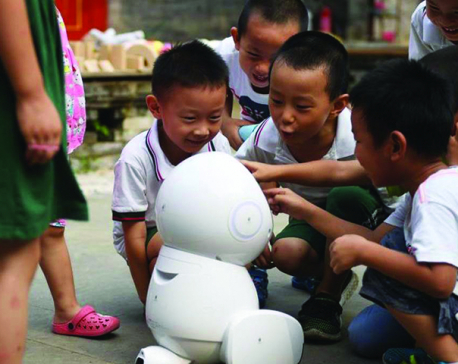
OR
#Opinion
Future of Healthcare: More Machines, Less Humanity
Published On: December 15, 2023 03:55 PM NPT By: Rohit Raj Bhatta

Rohit Raj Bhatta
The author is a medical student pursuing MBBS at Patan Institute of Health Sciences.news@myrepublica.com
More from Author
It may not be wrong to say that in todays’ date, Artificial Intelligence (AI) is the next big technological advancement that holds the power to change how we work and live. The burgeoning demand for AI is here to stay. And healthcare is no exception.
According to a report from Statista, the 11 Billion U.S. dollars market (2021) of AI in healthcare worldwide will see unprecedented growth only to be worth almost 188 U.S. dollars by 2030 at a rate of 37 percent from 2022 to 2030 . Thanks to the pandemic and the quest for capturing the market early, countries and companies are leaving no stone unturned in this game.
Imagine saving hours from your overworked brain by summarizing patient reports, managing appointments, and other administrative work to make time for real face-to-face interaction with patients. That is what we as healthcare professionals dream of and the same thing promised by AI creators. Sounds fanny and dramatic, and as lousy copywriting material as it may seem, these things are already happening in some countries.
AI-powered systems have taken the place for the good. You might be talking with chatbots about your health, and they may buffer a bit, but they will help you find answers from the plethora of articles on the internet. Natural Language Processing is a domain of AI being used in Chatbots, which is showing potential to improve telehealth efficiency. Be it in cancer diagnosis, chatbots, or pathology, AI is making things easier. High-risk conditions like sepsis, heart failure, and complex diseases like cancer are being detected by using AI-powered systems. Before, it used to schedule appointments; now, it possesses the power to call one. We may have summoned a Samurai to fight with the maladies.
AI in healthcare may be in its initial stages, but it has already started to expand its roots.
From passing what seems to be every Nepali doctor’s dream, U.S.M.L.E2, Chat-GPT, an AI-based language model, has shaken the world. Its variants are more notorious in the knowledge they provide. However, generative AI like Chat-GPT are not yet reliable or consistent with their texts. You will get output as you give prompts.
The complexity and rise of the number of data in healthcare will make AI to be extensively used in the future. Through various arenas like Machine learning (enabling AI to automate itself), Natural language processing(NLP), etc, AI has been fed to compile and analyze enormous amounts of data. Surgical robots are also there to perform less invasive surgeries and some stitches here and there.
Monitoring and preventing different diseases by analyzing tons of data from health and fitness monitors was never easy before. These monitoring devices can send timely reports of patients, and the analysis of these data will help in better preventing the disease and its treatment. It also shows promising results when used for the diagnosis and grading of breast cancer, cervical cancer, gliomas, defects in the GI tract, image analysis, as a triaging tool, and whatnot. It’s only a matter of time before AI takes over developing new drugs, treatments, and diagnoses, which, in some parts, it already is.
Integration of AI with wearable devices, genomics, and drug discovery are future advancements. Advancements in AI will enhance the interpretation of images, including X-rays and scans, leading to improved diagnosis and treatment of diseases. The FDA has already approved approximately 700 AI-enabled devices, predominantly in radiology3, where the technology has demonstrated significant potential in interpreting X-rays.
AI's predictive analysis anticipates epidemics and trends by analyzing vast datasets, learning from previous outbreaks. These insights provide early warnings, helping healthcare workers allocate resources efficiently during public health emergencies.
As the race for the top continues, tech giants and firms have already begun investing in what they hope is the future. ‘Oracle’ has already launched its Clinical Digital Assistant4, which shows some promising future. Its NLP capabilities reduce clinicians' manual work, allowing more time for patient care. On the patient side, it simplifies tasks such as appointment booking, billing queries, health information retrieval, and treatment-related inquiries.
Apart from the super fancy stuff, regulations for this new toy are still immature. WHO has called for safe and ethical use for health, considering the fact that patient autonomy, well-being, transparency, and equity, among others, are in hand. WHO Director-General stressed that “Artificial intelligence holds great promise for health, but also comes with serious challenges, including unethical data collection, cybersecurity threats and amplifying biases or misinformation.” Western nations, particularly, are still in talks on how to regulate this before it’s too late. The responsibility to regulate comes at the price of curbing innovation. The balance is what we need.
But, one thing mortal humans are really confident about apart from their ineffectual devotion to work, is that AI has a long way to go to attain the listening skills, empathy, respect, and personal preference for patient choices. Everything is not as rosy as it may be seen here. The digital divide between those who have access to the technology or those who choose other ways to have one, consent to data of individuals, algorithmic biases, laws, and ethical concerns all shadow the mirage of AI. There is always a possibility of hallucinations (errors) of AI models, which may cost lives, for which the accountability factor is also of concern. Data breaches in the healthcare industry may have serious repercussions. The probability of losing the human touch and the need for digital trust are one of the key concerns.
If the data processed by AI are already diagnosed, treated, and from past medical experiences, provided new cases, AI-powered systems may malfunction. AI needs constant updates and training. Doctors will still be necessary because of their ability to contextualize data produced by AI, interact with patients, and handle difficult medical situations. Still, algorithms must be infused with a trilogy of medical science, ethics, and individual characteristics to maintain parity. Personalized medicine, which adapts medications based on particular genetic profiles and health information, will become the norm.
AI can be a boon for countries like Nepal, with a considerable equity gap. At the same time, investing in new technology may not seem reasonable when there are other, more significant problems. But, AI is not just for tackling the small fry, but believed to help in alleviating those bigger sharks. Some companies like NAAMI and Wiseyak working in Nepal promise to solve health problems using technology. For example, NAAMI is working on an AI-powered screening tool for cervical cancer, which takes help from smartphone-captured images of the cervix to visually inspect and detect the condition even remotely.
Another one currently working is CHEERS (Children, Eye, ENT, and Rehabilitation Services) in Bhaktapur. Their AI models help to predict glaucoma and diabetic retinopathy as they have fed thousands of image data to the AI system. These diseases are often overlooked or missed at the clinics, but the models make the diagnosis more than 90% accurate. Similarly, The IBM Watson for Oncology platform utilizes AI to analyze extensive medical literature and data, offering specific treatment strategies for cancer patients.
Incorporating telemedicine and AI will save people expensive hospital trips for those who can’t afford it. It will help community health workers to upgrade their skills as they can confirm and compare the diagnosis with the ones made by AI and at urban hospitals.
The shady side is Nepal has a problem with Electronic Health Records (EHR). And being a diverse nation, biases for different cohorts may arise. Due to the scarcity of data in rural settings, AI will starve. And winning people’s trust is another nightmare. Questions may also arise, “Who is to blame when AI makes a blunder?”
Overall, this is a rapidly changing industry. Innovations are coming in every jiffy. AI has the potential to transform healthcare, influencing diagnosis, treatment, drug development, and overall accessibility and affordability. However, ethical concerns must be addressed. Further AI development can enhance face-to-face interactions among healthcare workers, nurturing doctor-patient relationships, and boosting hospital efficiency. But humans tend to fall for respect, empathy, and listening. We don’t want a language model to repeat the text written in medical books. So, As they say, Artificial Intelligence (AI) won’t replace jobs, but those who use AI will replace those who do not.
You May Like This

Shattering the Shackles of Untrammeled Rationalism
Nepal is afflicted by a distressing malady. The unchecked dominance of untrammeled rationalism has worsened societal problems, causing increased suffering... Read More...

The Nepal we need in post-COVID-19
The coronavirus pandemic is forcing Nepalis to rethink the path of development. We are entering a new reality of frequent... Read More...

AI for human development
AI can already detect early signs of diabetes from heart rate sensor data, help children with autism manage their emotions,... Read More...







Just In
- NRB to provide collateral-free loans to foreign employment seekers
- NEB to publish Grade 12 results next week
- Body handover begins; Relatives remain dissatisfied with insurance, compensation amount
- NC defers its plan to join Koshi govt
- NRB to review microfinance loan interest rate
- 134 dead in floods and landslides since onset of monsoon this year
- Mahakali Irrigation Project sees only 22 percent physical progress in 18 years
- Singapore now holds world's most powerful passport; Nepal stays at 98th











Leave A Comment